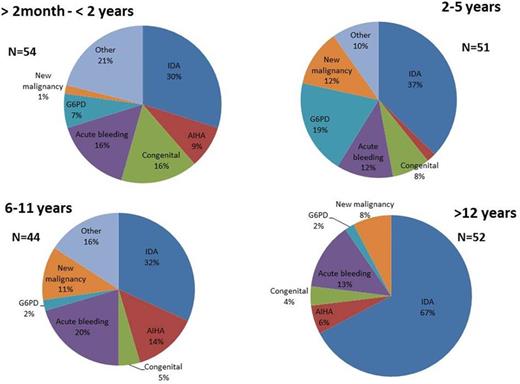Abstract
Background: Anemia is a global public health problem affecting both developing and developed countries. Most literature on severe anemia in children is reported from developing countries, where malaria infection and malnutrition are the main causative factors. According to the world health organization (WHO) report, in Israel, as in many western countries, anemia is considered a mild public health problem (1). The aim of this study it to analyze the causative factors and management of severe anemia in children living in a country where anemia is not considered a major health problem.
Methods: The electronic hospital records of all children (≤16 years) with hemoglobin < 7.0 g/dl presenting to two largest Emergency Department (ED) in Jerusalem from 2008 to 2013 were retrospectively reviewed. Data including demographic characteristics, presenting signs and symptoms, laboratory findings, causal factors and management were extracted from medical records and analyzed. Cases secondary to surgical bleeding, chemotherapy, known chronic anemia or developing during prolonged admission were excluded. The diagnosis of iron deficiency anemia was based on low plasma iron and ferritin levels with compatible blood smear, when available. If unavailable, the diagnosis was based on the findings of low MCV and MCH for age with increased RDW.
Results: A total of 227 children (female 123, 54%) at a median (range) age at of 4.5 years (1 day-15.5 years) were included. The median (range) hemoglobin at presentation was 6.3 (2.6-6.9) g/dl. In the entire cohort the most common etiologies for severe anemia were iron deficiency anemia (IDA) (38%) and acute hemolysis; autoimmune (AIHA) (8.5%) or G6PD deficiency (8%). The distribution of etiologies for severe anemia differed between infants, pre-school age, school age and adolescents (Figure 1). While the diagnosis of IDA was the most common in all age groups, some diagnoses such as G6PD deficiency and congenital anemia were more common in the younger age groups (up to 6 years) compared to the older ages. Children diagnosed with IDA were significantly older; median (range) 9.5 years (4 months-15.5 years), compared to children with other diagnoses, 3 years (1 day-15.5 years) (p<0.001), with a trend for more females diagnosed with IDA, 53/85 (62%) compared to other diagnosis, 70/142 (51%) (p=0.056). Transfusion of red blood cells (RBCs) was used as a sole or part of treatment in 144 (63%) children. In the entire cohort the use of RBCs transfusion was associated with lower baseline hemoglobin levels and higher heart rate at presentation, but not with the child's age. A third of children with IDA received RBCs transfusion. In this subgroup, the use of RBC transfusion was associated with underlying disease and baseline higher MCV. The OR (95% CI) for receiving RBC transfusion in children with underlying disease was 3.05 (1.16-7.94). The use of RBC transfusion was not associated with age, gender, heart rate at presentation and hemoglobin levels. In adolescents with menorrhagia, almost all those admitted to the Gynecology Department (10/11) received RBC transfusion compared to a third (5/17) of those admitted to the Pediatric Department (p=0.001). No other differences, i.e. history of acute blood loss, heart rate at presentation, hemoglobin level and MCV, were found between groups.
Discussion:
The distribution of etiologies for severe anemia in our cohort is different compared to the publications from developing countries. Still, iron deficiency, a potentially preventable medical problem, is the leading cause for those cases. The use of RBCs transfusion in almost a third of children with IDA may result in unnecessary transfusion related complications. The association of RBCs transfusion with underlying disease, higher MCVand admitting department may reflect the physicians' decision process. Improved attempts for prevention of IDA in all aged children and guidelines for RBCs transfusion in children presenting with anemia to the ED are needed.
(1) Worldwide prevalence of anaemia 1993-2005: WHO global database on anaemia. Available from: whqlibdoc.who.int/publications/2008/9789241596657_eng.pdf.
Etiologies for presentation of children in the Emergency Department with severe anemia (hemoglobin < 7 gr/dl) per age groups * "Other" (<10 cases each in the entire cohort), e.g. chronic renal failure, acute infection and metabolic diseases, etc.
Etiologies for presentation of children in the Emergency Department with severe anemia (hemoglobin < 7 gr/dl) per age groups * "Other" (<10 cases each in the entire cohort), e.g. chronic renal failure, acute infection and metabolic diseases, etc.
No relevant conflicts of interest to declare.
Author notes
Asterisk with author names denotes non-ASH members.


This feature is available to Subscribers Only
Sign In or Create an Account Close Modal